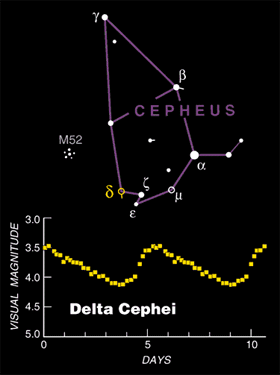
Graphic from Sky and Telescope's website http://skyandtelescope.com/observing/objects/variablestars/article_160_1.asp
 Copyright © Michael Richmond.
This work is licensed under a Creative Commons License.
Copyright © Michael Richmond.
This work is licensed under a Creative Commons License.
By comparing the color-magnitude diagrams for clusters of stars in our Milky Way Galaxy, we can calculate their relative distances. Hipparcos observations of a few very close clusters (such as the Hyades or Pleiades) allows us to turn these relative distances into absolute ones. But we can't measure the brightness of main-sequence stars in other galaxies very accurately -- they are just too far away and therefore too faint. How can we determine the distances to other galaxies?
There are a number of different methods, but the main technique depends on the properties of a particular class of stars, called Cepheid variables.
Cepheids are great relative distance indicators, but we need to know how just how luminous they are in order to calculate absolute distances. For better or for worse, astronomers have decided to base all their Cepheid distances on a single galaxy: the Large Magellanic Cloud, or LMC.
The star delta Cephei varies by about 50% in brightness over a period of about 5 days:

Graphic from Sky and Telescope's website
http://skyandtelescope.com/observing/objects/variablestars/article_160_1.asp
There are many other stars which vary in a similar way, showing a smooth light curve which often features a quick rise and slow fall. For example, the star eta Aquilae:
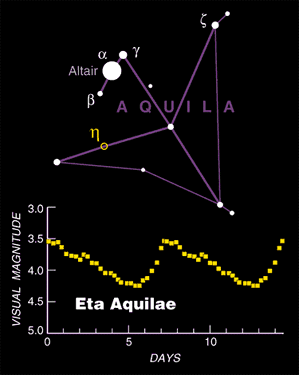
Graphic from Sky and Telescope's website
http://skyandtelescope.com/observing/objects/variablestars/article_160_1.asp
When one measures the radial velocity of Cepheids, one finds a cyclic variation, which has the same period as their change in brightness.
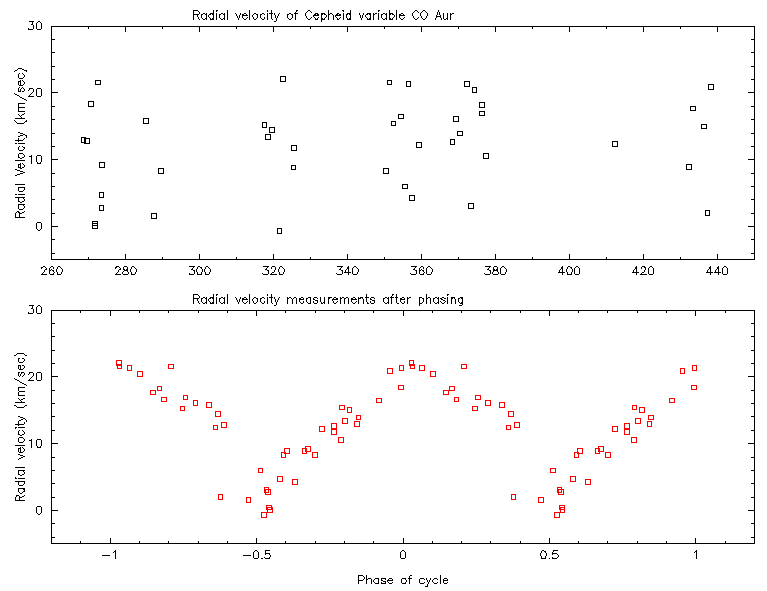
It turns out that Cepheids are pulsating variables: their outer atmospheres puff outwards, making them larger and brighter, then cool off and fall back, making them fainter.
Some of the stars have short periods of a few days; others take weeks to complete one cycle in brightness. All of them are relatively bright, young stars. They appear in the color-magnitude diagram in an area like this:
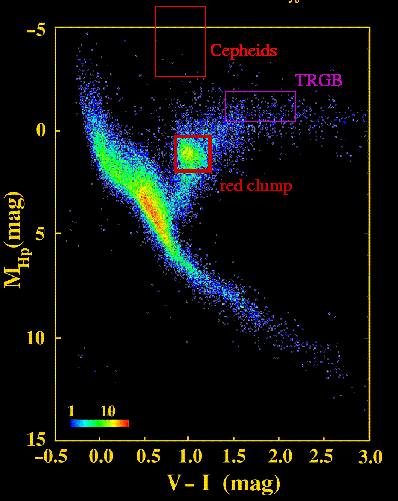
As the figure shows, these stars are
So, how are these stars going to help us to measure distances?
In the early 1900s, the Harvard College Observatory was one of the leading astronomical research institutions in the world. It employed many men to build equipment and go observing, many women to examine and measure photographs and perform numerical computations, and a few lucky male astronomers to analyze the results and publish them.
One of the women, Henrietta Leavitt, was given the task of examining photographic plates of stars in the Small Magellanic Cloud (SMC), one of the little satellite galaxies which orbits our Milky Way. She used a clever technique to find variable stars: given two photographs from different dates (both of which were negatives, showing black stars on a white background),
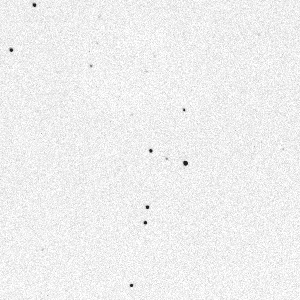
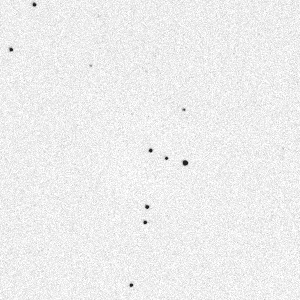
she would make a positive copy of one
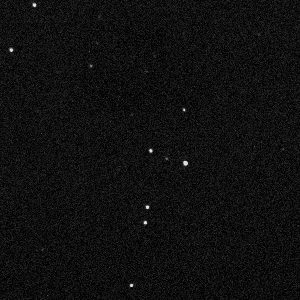

and lay it over the negative original of the other. Stars which had the same brightness on both plates would very nearly cancel each other out, leaving a plain grey; but stars which varied from one plate to the other would leave bright or dark rings.
After several years of work, Miss Leavitt (for that was the form of address in those days) found 1,777 variables in photographs of the SMC and LMC. A small fraction of these were Cepheids. She noticed that the Cepheids with long periods were brighter than those with short periods, whether she used the magnitude at maximum light or minimum light.
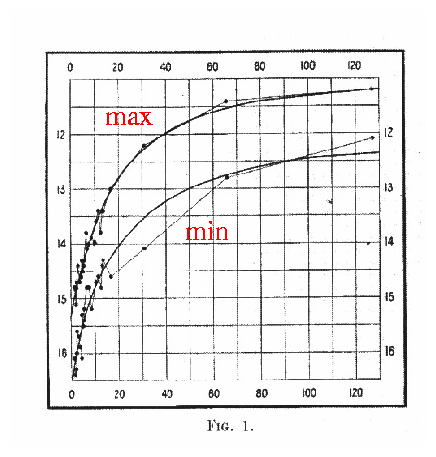
The effect was even more striking when she made a logarithmic plot of both variables (brightness in magnitudes versus logarithm of the period):
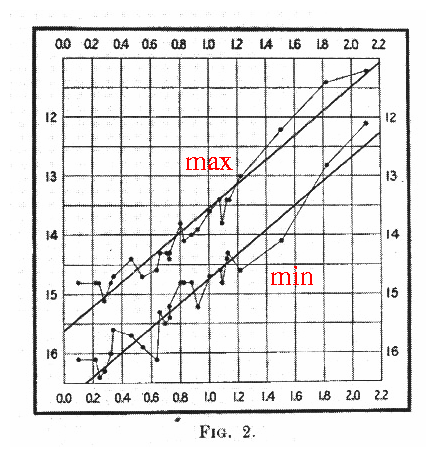
She wrote
The two resulting curves, one for maxima and one for minima, are surprisingly smooth, and of remarkable form. In Figure 2 ... a straight line can readily be drawn among each of the two series of points corresponding to maxima and minima, thus showing that there is a simple relation between the brightness of the variables and their periods ... Since the variables are probably at nearly the same distance from the Earth, their periods are apparently associated with their actual emission of light, as determined by their mass, density, and surface brightness.(emphasis added)
Her results, including these words, were published by Edward C. Pickering, one of the lucky male astronomers who took a great deal of the credit for the work done by the entire Harvard College Observatory crew. See Harvard College Observatory Circular, vol 173, p. 1, 1912.
Leavitt's discovery of a period-luminosity relationship in Cepheid stars was a breakthrough. The period of a Cepheid is relatively easy (though tedious) to measure. If we can figure out the luminosity which corresponds to any particular period, we may use the inverse-square law to estimate the distance to the star.
In recent years, advances in detectors and observing techniques has permitted us to measure this period-luminosity relationship with greatly improved accuracy. Here's a 1960s version of the period-luminosity relationship based on photographic measurements of Cepheids in the Magellanic Clouds:
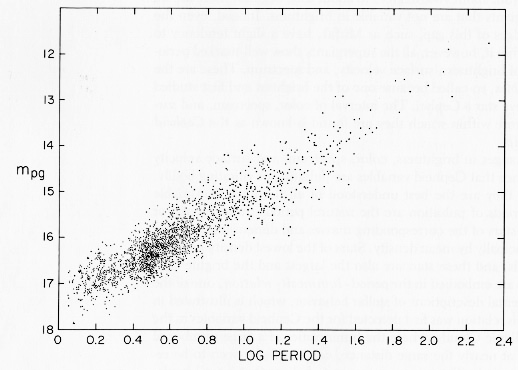
Here's a similar plot, based on data collected by the OGLE collaboration with CCD cameras in the 1990s:
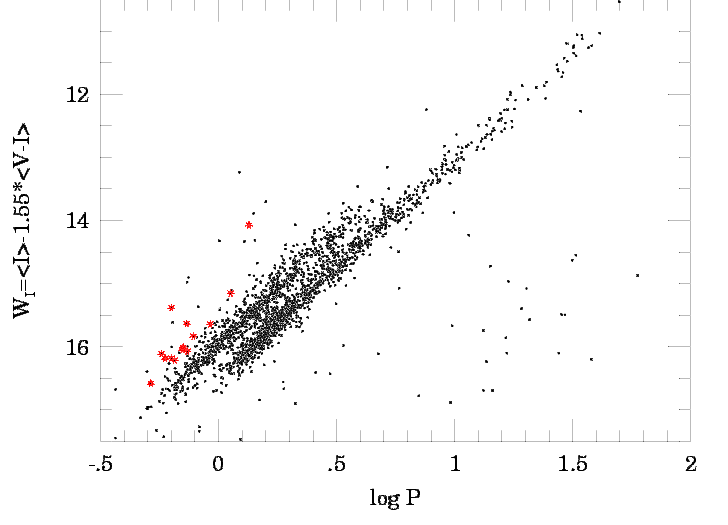
Notice that there are really two tracks in this diagram: the one on the left belongs to Cepheids pulsating in the "first overtone" mode. Back in the old days, we couldn't detect this difference, and so mixed the two sets of stars together -- which added quite a bit of error to distance measurements.
So, it looks as if Cepheids might provide astronomers with an ideal means to measure distances to other galaxies. Just
There's just one weak point: how far away is the Large Magellanic Cloud? If we don't know that, we can't convert the relative distances to absolute distances in parsecs. Hmmmm....
If we knew the distances to Cepheid variables in our own Milky Way galaxy, we could compare them to the Cepheids in the LMC, and measure its distance that way. Unfortunately, none of the Cepheids in our own galaxy are close enough for Hipparcos to measure their distances accurately. Rats!
There are a very few Cepheids found within some distant open clusters in the Milky Way. We can use the main-sequence fitting technique to compare those distant open clusters to nearby open clusters, and thereby determine their distances, which in turn give us their Cepheids' distances. Alas, there are so few of these stars in open clusters that this method of calibration still has a relatively high uncertainty.
So, is there any other way -- without using Cepheids -- by which we can determine the distance to the LMC?
Astronomers have tried many different methods to measure the distance to the LMC, since we base upon it all distances to other, more distant, galaxies. Here's an incomplete list of those methods:
RR Lyrae stars are bright enough that we can see them easily in the Magellanic Clouds, and in a few other members of the Local Group. But we can't measure them very well in the Andromeda Galaxy, or in any galaxy beyond the Local Group.
The amount of dust between us and a binary star can affect the calculated distance. Two sets of astronomers have used the same eclipsing binary (HV 2274) to measure the distance to the LMC -- and get results which differ by about 8 percent!

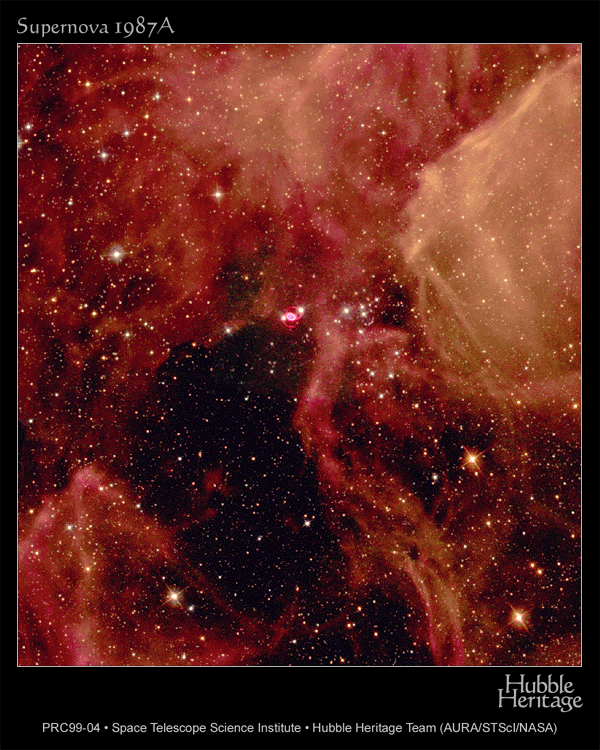
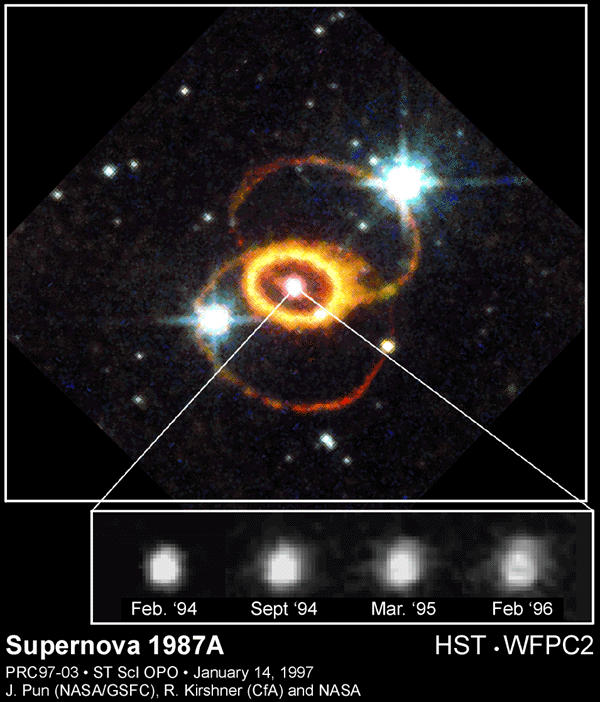
Astronomers watched as the material in the rings was lit up by radiation from the supernova, in the first few months after it exploded. It was possible to estimate the absolute diameter of the ring, in kilometers, based on the speed of light and some spectral measurements. Knowing the absolute diameter (in kilometers), and measuring the angular diameter (in degrees), we can use trigonometry to figure out the distance to the supernova .. and, therefore, the distance to the LMC.
However, different astronomers have used different models for the geometry of the rings to end up with very different distances, and it's not clear who (if anyone) is correct.
Here's a table showing some recent results for the distance to the LMC, using these methods:
method distance to LMC
---------------------------------------------------------
RR Lyrae 45 kpc +/- 7 kpc
46 4
51 10 double-mode (Kovacs 2000)
main-sequence fitting 52 +/- 3
eclipsing binary stars 48 +/- 3 HV 2274 (Nelson et al 2000)
44 +/- 6 HV 2274 (Udalski et al 1998)
41 +/- 13 a different system
tip of red giant branch 52 +/- 5
51 6 DENIS (Cioni et al. 2000)
red clump 44 +/- 6
52 +/- 5
Mira variables 50 +/- 9
SN 1987A 52 +/- 4
<= 47 +/- 2
It seems clear that the distance to the LMC is somewhere between 40 and 55 kiloparsecs -- but there's still quite a range of possible values. There's currently quite a debate between those who favor the "short" distance (about 44 kpc) and those who prefer the "long" distance (about 51 kpc).
Since we use the distance to the LMC to set the zero-point for Cepheid variables, the distances to all other galaxies are linked to that of the LMC. The current uncertainty in the distance to the LMC means that distances to all other galaxies are also uncertain, by about 10 percent or more.
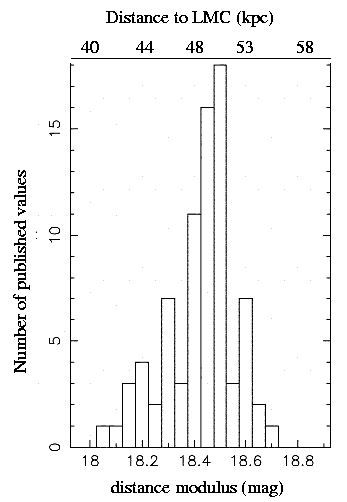
For more information, see
 Copyright © Michael Richmond.
This work is licensed under a Creative Commons License.
Copyright © Michael Richmond.
This work is licensed under a Creative Commons License.